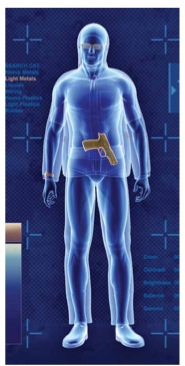 Paul A. Oakley, M.Sc., DC
Paul A. Oakley, M.Sc., DC
CBP Research & Instructor
Private Practice New Market, Ontario, Canada
INTRODUCTION
As you have likely heard or already have experienced, the Transportation Security Administration has implemented new full-body scanners in the largest airports in an attempt to thwart off terrorist attacks. This was in response to last Christmas’ underwear bombing attempt, where a Nigerian man was wearing ‘hard-to-detect’ explosives. The TSAs goal was to have 500 body scanners deployed by the end of 2010; 1000 body scanners deployed by the end of 2011. As of November 20, 2010 there had been 385 full-body scanners in use at 68 US airports.1,2
The new full-body scanners use either ‘millimeter wave’ or ‘backscatter x-ray’ technologies. Millimeter wave technology reflects extremely high frequency radio waves off the body which forms an image. Backscatter x-ray technology produces an image by measuring the reflections of low-intensity x-rays. Both technologies work by producing body contour images of the body in order to see objects that could be hidden under clothes.
Terrorism vs. Human Rights
Although these new anti-terrorism screening procedures have been considered both invasive and harmful, the TSA states that these are “safe and necessary sacrifices to ward off terror attacks.”2 Travelers who do not want radiation exposure from the new scanners would have to then face an ‘enhanced pat-down’ that includes checks inside the thighs and buttocks by someone of the same sex.
There has been much controversy in the deployment of these body scanning techniques as many organizations contend that the governments forced use violates basic human rights. In fact, the Electronic Privacy Information Center (EPIC) filed a lawsuit in July, 2010 to ‘suspend the deployment’ of full-body scanners at airports in the US as they claim the government has violated the Administrative Procedures Act, the Privacy Act, the Religious Freedom Restoration Act, and the Fourth Amendment as citizens are subjected to virtual strip searches without any evidence of wrongdoing!1,3

The Radiation Exposure Issue
Regardless of the many levels of controversy, the issue regarding the scanners from a radiation exposure point of view is whether the backscatter x-ray technology delivers detrimental levels of ionizing radiation exposures to airport travelers and pilots. The backscatter x-ray has an emitter which emits low intensity x-rays and its detectors measure reflected x-rays to create an image.
The TSA states that the exposure is about 1/1000th of that received from a chest x-ray. However, according to Peter Rez, a physics professor from ASU, the calculated exposure levels are more in the line of 1/50 - 1/100th of a chest x-ray. Rez stated that the risk of causing DNA damage, thought to cause cancer, would be estimated to be about 1/30,000,000 (yes 30 million). The TSA screens about two million travelers a day. This indicates, according to these estimates, that one passenger in 15 days, or about two passengers a month, or about 24 passengers a year could have a cancer develop due to being screened at the airport.
On the surface it may seem a very risky, health-costly sacrifice to provide security for the American public. For this reason, a letter4,5 was sent from a few professors at the University of California, San Francisco (UCSF) about the health risks associated with the new scanners as estimates are actually much higher than estimated by the TSA as the dosage is focused on the skin and surrounding tissues. Estimates are usually calculated as if the dose is distributed throughout the whole body. Other opponents have suggested that the risks to pregnant women and children are also significantly higher than the estimates given by the TSA.6
In a press release, the National Council on Radiation Protection (NCRP)7 has stated that cancer risk estimates are completely inaccurate as reported by ‘scanner opponents’: “the summation of trivial average risks over very large populations or time periods into a single value produces a distorted image of risk, completely out of perspective with risks accepted every day, both voluntary and involuntary.”
The NCRP7 also states the effective dose from these new airport scanners is limited to 0.01 mrem or less per scan. This would allow a given individual to be able to safely receive 2500 scans per year (assuming each scan is less than 0.01mrem without exceeding the administrative control of 25mrem to a member of the general public for a single source or set of sources under one control). Thus, assuming a 250 workday year, this safety margin would correspond to 10 scans per day – which would likely not occur!
Putting this into better perspective, the TSA has also set the limit of the dose of exposure from the backscatter x-ray scanners to be no more than the equivalent of 2 minutes of the expected exposure time while flying in the airplane. Other estimates have determined that the exposures are about 42-60 minutes of ‘background’ radiation7,8 – that is, radiation we are constantly exposed to, unknowingly for most people every day, that we cannot ever possibly escape!
Assuming a cervical series x-ray pair is 44mrem, and a lumbar series x-ray pair is 130mrem, then it would take 4,400 and 13,000 x-ray scans at the airport, respectively, to contribute the equivalent of these radiation exposures of common x-rays that many chiropractors take every day of their patient populations! According to the Health Physics Society (1996), risks of health effects below 100mSv (227 Cervical series or 77 Lumbar series9) that is, 50 to 100 times the exposure levels from x-rays) health risks are nonexistent (too small to observe).10 This equates to 1,000,000 body scans! Suffice to say, this will never happen.
SUMMARY
In conclusion, the risk of the miniscule amounts of ionizing radiation from the backscatter x-ray technology employed in the full-body scanners should be considered zero – and unfortunately, not even in the range of ‘hormesis’ – where there could be a health enhancement effect. The largest threat about this new scanning technology lies in the privacy domain. For example, despite the TSA denying the ability to save naked images of travelers, on November 16, 2010, 100 of an apparent 35,000 saved body scan images were leaked onto the internet!2
REFERENCES
- http://en.wikipedia.org/wiki/Full_body_scanner
- HTTP://MSNBC.MSN.COM
- Lawsuit challenges airport full-body scanners — The Boston Globe. Boston.com (2010-08-04).
- UCSF letter to Holdren concerning health risks of full body scanner TSA screenings 4-6-2010. Scribd.com.
- Carmichael, Scott. (2010-05-18) Scientists question safety of airport full body scanners. Gadling.com.
- Full-Body Scanners to Fry Travelers With Radiation. Prisonplanet.com (2009-12-31).
- http://www.ncrponline.org/Press_Rel/Commentaries/Comm_16_Press_Release.pdf
- http://www.hpa.org.uk/Topics/Radiation/UnderstandingRadiation/UnderstandingRadiationTopics/BodyScanners/
- Oakley PA, Harrison DD, Harrison DE, Haas JW. Evidence-Based Protocol for Structural Rehabilitation of the Spine and Posture: Review of Clinical Biomechanics of Posture (CBP®) Publications. JCCA 2005;49(4):270-296.
- Mossman, K. L., Goldman, M., Masse, F., and et al. Radiation risk in perspective: Health Physics Society position statement. 1996. Idaho state University Dept of Physics and Health Physics Web site: (www.physics.isu/radinf/hprisk.htm).